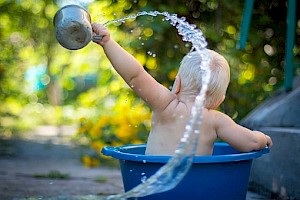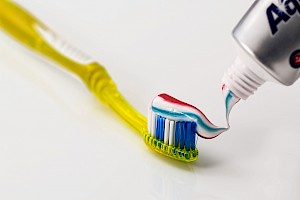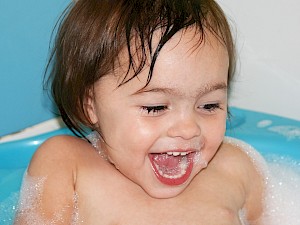Sometimes we find it hard to find specific time to sit down and practice speech and language skills with our children. Little do we know, we can easily work on speech and language skills in our everyday activities. Bath time is a relaxing and great time to learn. You can easily make it seem like they are not doing any work at all and they can have lots of fun in the water. You can make the time you spend together a little more special and fun. Children learn best through play, laughter and lots of fun in the water.
Here are some speech and language goals that you can target during bath time:
Sequencing: Since bath time is already a routine, you can easily add in sequencing. You can tell them the order that you are going to wash them and what to do next. For example, first we are going to wash your hair, next we are going to wash your body and then your arms and legs. After telling them the order of what you will do in a bath routine for several times, see if they can tell you what to do next. If they missed a step, no worries, you can model the correct step back.
Learning body parts: You can name each part of your child’s body as you wash them. Arms, legs, feet, tummy, back, face, ears, nose and even their bottom, they often find this part the funniest. After a few times teaching your child the names to their body parts, let them have a go. See if they can tell you where they would like you to wash.
Action words: Bath time is great time to teach your child action words with water. For example, pouring, blowing, splashing, and swimming. You can use toys for this activity and talk about what they are using the toys to do or what the toys are doing. For example, using a bucket to pour the water and make the rubber duck swim in the bathtub. You can talk about what you are doing to your child as you are washing them as well. For example, washing their hair, washing their hands, rubbing their feet, brushing their teeth etc.
Concepts of floating and sinking: You can bring in different types of toys to your bath time. Heavy toys and light toys. You can show your child and tell them if the toy is floating on top of the water or sinking all the way to the bottom. After teaching your child this concept you can step it up and even ask your child to predict if the toy you are going to put in will sink or float.
Speech sounds: You can bring in toys with targeted speech sounds that you are trying to practice with your child. For example if they are practicing /f/ sounds, you can bring in a toy fish in the bath. You can emphasis on the /f/ sound every time you talk about the toy fish. Remember, repetition is key for developing speech sounds.
Developing your child’s language skills is important in preparing them for school and more learning. You can easily make your normal routine into a fun learning time. Be sure to repeat any new words lots of times to support your child’s learning. If your child makes a mistake, that’s okay, you can model the correct way back to them. Remember to give your child praises and encouragements for trying.
We hope these ideas will start you thinking about ways to help your child develop their communication skills during your everyday activities. If you have concerns about your child's communication development we recommend you seek professional advice early. Early intervention has been well documented as being best to support children's development. If you live in our local area and have concerns contact us now.
Have fun learning!
Related Blog Posts
If you liked this post you may also like:
7 ways to begin pretending
The Benefits of Joint Speech Pathology and Occupational Therapy Sessions (SPOT)
Christmas activities
Word combinations



